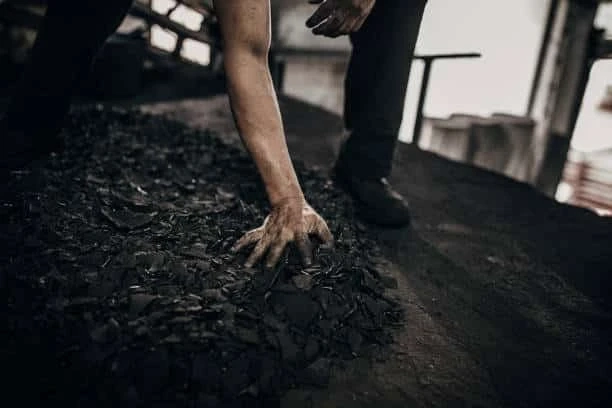Coconut shell charcoal is increasingly gaining worldwide recognition. As a completely natural and environmentally friendly biofuel, it serves as an alternative fuel to traditional options like fuelwood, kerosene, and other fossil fuels. Additionally, it is utilized in the production of charcoal briquettes, catering to various purposes such as shisha, cooking, BBQ, and industrial boilers.
The coconut shell consists of around 30% coconut fiber and up to 70% pith. With an ash content of approximately 0.6% and a lignin percentage of about 36.5%, it possesses properties conducive to easy conversion into charcoal. Yet, the process of creating charcoal briquettes from it requires the use of a coir pith briquetting machine, which parallels the technique used in wood briquetting.
Interested in discovering the process of creating charcoal briquettes from coconut shells? Continue reading for detailed instructions!
Steps To Make Charcoal Briquettes From Coconut Shells
The process of making coconut shell charcoal involves these steps: Carbonization, Crushing, Blending, Drying, Briquetting, and Packaging. Let’s discuss each of these coconut shell charcoal briquetting steps in detail.
Carbonizing Coconut Shells into Charcoal
Coconut shells can be directly transformed into charcoal using a carbonizing machine. You’ll find various types of carbonization furnaces, most of which are suitable for producing coconut shell charcoal. In small-scale charcoal production, options like the hoist type and horizontal airflow carbonization furnace are available. For larger charcoal factories, the continuous carbonizing machine is a recommended choice.
Put coconut shells into a carbonization furnace, elevate the temperature to 1100°F (590°C), and subject them to carbonization within a moisture-free, oxygen-free, high-temperature, high-pressure environment. Alternatively, you have the option of employing a significantly more affordable carbonization approach by burning coconut husks in a spacious pit. However, it\'s important to note that this method might necessitate a longer duration, potentially lasting around 2 hours or more for the entire process.
Crushing Coconut Shell Charcoal
After carbonization, coconut shell charcoal retains its shell structure or fractures into fragments. To prepare for charcoal briquette production, employ a hammer crusher to crush the charcoal into 3-5 mm particles. Coconut charcoal in powder form significantly facilitates shaping and minimizes coir pith briquetting machine wear. Smaller particle sizes enable easier compression into charcoal briquettes.
Mixing Coconut Shell Powder with Water and a Binder
Charcoal powder lacks viscosity, necessitating the addition of a binder to facilitate the formation of briquettes. Incorporating a binder results in more robust charcoal briquettes with smoother surfaces. Commonly used binders, such as corn starch and cassava starch, are food-grade and emit no harmful gases upon burning. Typically, the binder ratio ranges between 3-5%.
Concerning the moisture content of the charcoal, it is ideal to maintain it between 20-25% post-mixing. During production, a reliable technique exists to determine moisture adequacy. Simply take a handful of the mixed charcoal and compress it by hand. If the charcoal powder retains its shape without crumbling, the humidity level meets the required standard.
Drying Coconut Charcoal Powder
A dryer is installed to reduce the water content of coconut charcoal powder to below 10%. The more diminished the moisture content, the more efficient and effective the burning process becomes.
Briquetting Coconut Shell Charcoal
Following the drying process, the carbonized coconut powder is fed into a roller-type briquette machine. Subjected to elevated temperatures and pressures, the powder is compressed into spherical forms, and smoothly released from the machine. These formed shapes can range from pillows, ovals, and rounds, to squares.
Drying Charcoal Briquettes
If you haven’t dried coconut shell charcoal powder before briquetting it, you can do it in this step. Upon production by the charcoal briquette machine, all charcoal briquettes retain moisture and require drying before their use as fuel or for sale in the market. Typically, there are two methods for drying charcoal briquettes, which parallel the technique used in wood briquetting: natural sun drying and machine-based drying.
Packing Charcoal Briquettes
Package and market coconut charcoal briquettes in securely sealed plastic bags.
Final Words
Certainly, coconut shells serve as excellent raw materials for producing coconut shell charcoal. The transformation process involves eliminating moisture from the raw material within a controlled air supply. This necessitates a specialized charcoal drum for carbonizing the coconut shells, ensuring the production of top-quality charcoal. Widely applied in the food and metallurgical sectors, coconut shell charcoal also serves as an exceptional source for manufacturing activated carbon and more.
To avail of the best coir pith briquetting machine, contact EcoStan Machineries!



